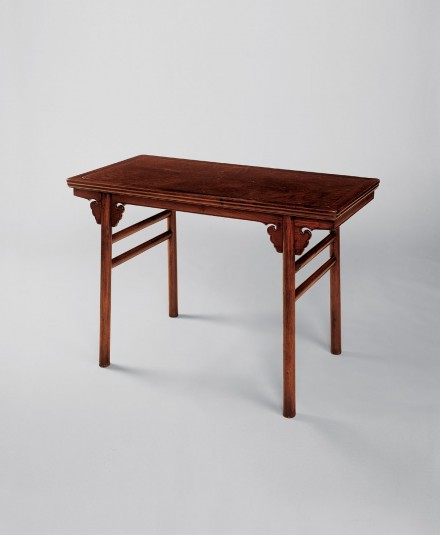J.J. Lally & Co., Oriental Art / New York City, New York
MenuPast Exhibition
The Gordon Collection:
Chinese Ceramics and Works of Art
March 12 - April 4, 2009

67.
A MING HUANGHUALI AND BURLWOOD SMALL PAINTING TABLE
17th Century
of recessed-leg construction, the top with a round-cornered frame of well-figured huanghuali enclosing a single piece of huamu (burl) with rounded corners, the very slightly splayed legs joined into the top by tenons securing the aprons and supported by cloud-shaped spandrels, with a finely carved beaded edge detailing both the spandrels and the apron, the legs also joined at the narrow ends by double transverse stretchers, the wood retaining original patination and with the original clay, ramie and red lacquer coating substantially intact on the underside.
Width: 51 inches (130 cm)
Depth: 24 1⁄2 inches (62 cm)
Height: 32 inches (81 cm)
Compare the huanghuali painting table of this rare form in the collection of the Shanghai Museum, illustrated in The Chuang Family Bequest of Fine Ming and Qing Furniture in the Shanghai Museum, Hong Kong, 1998, no. 31, pp. 80-81. Another huanghuali painting table in the collection of Wang Shixiang is illustrated in Connoisseurship of Chinese Furniture: Ming and Qing Dynasties, Volume II: Plates, Hong Kong, 1980, no. B114, p. 112.
Compare also the related example illustrated in the exhibition catalogue entitled Splendour of Style: Classical Furniture from the Ming and Qing Dynasties, Natural History Museum, Taipei, 1999, p. 141.
明 黃花梨鑲樺木畫案 寬 130 厘米 深 62 厘米 高 81 厘米
67.
A MING HUANGHUALI AND BURLWOOD SMALL PAINTING TABLE
17th Century
Width: 51 inches (130 cm)
Depth: 24 1⁄2 inches (62 cm)
Height: 32 inches (81 cm)